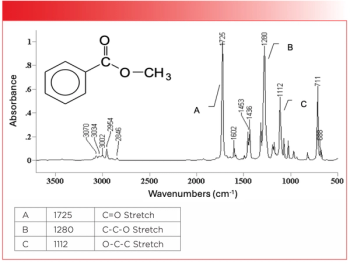
The Top 13 Articles from Spectroscopy in 2013
Everyone loves a list, and the editors of Spectroscopy are no exception! In 2013, Spectroscopy covered a wide array of topics throughout the year to bring you the most relevant information for your work, on topics ranging from selecting the right ICP-MS system to deciding which Raman technique is right for you, from our annual salary survey to calibration transfer. Here is a list of 13 popular articles and columns from 2013
Everyone loves a list, and the editors of Spectroscopy are no exception! In 2013, Spectroscopy covered a wide array of topics throughout the year to bring you the most relevant information for your work, on topics ranging from selecting the right ICP-MS system to deciding which Raman technique is right for you, from to our annual salary survey to calibration transfer. Here is a list of 13 popular articles and columns from 2013:
1. Polystyrene Film as a Standard for Testing FT-IR Spectrometers
R.A. Hoult, B. Perston, and R.A. Spragg
Polystyrene film is useful for routine checking of FT-IR spectrometer performance, but variations in film thickness and scattering can cause large variations in the results.
2. Femtosecond vs. Nanosecond Laser Pulse Duration for Laser Ablation Chemical Analysis
Richard E. Russo, Xianglei Mao, Jhanis J. Gonzalez, and Jong Yoo
Although the choice of laser is still highly dependent on the application requirements, there are distinct fundamental effects attributed to the laser pulse duration that drive the ablation sampling process. Here, we explain the differences between nanosecond and femtosecond laser ablation.
3. How Complete Are Your Data?
R.D. McDowall
A look at what the requirements are for “complete data” for laboratories working under the FDA GMP regulations. We also review the observations listed by inspectors on 483 forms from 2006 to 2012, to assess the common mistakes companies make.
4. Logger Rhythm
David W. Ball
A logarithm is a mathematical function that shows up in some forms of spectroscopy. Understanding what it is can give us a better appreciation for its function in our fields.
5. How to Select an ICP-MS System: Some Important Considerations
Robert Thomas
Evaluation guidelines and important factors for laboratory scientists to consider when choosing an inductively coupled plasma–mass spectrometry instrument.
6. Quantum Cascade Lasers for Infrared Spectroscopy: Theory, State of the Art, and Applications
Laura Bush
Mid-infrared quantum cascade lasers, recently developed and commercialized, have unique properties that advance the analytical capabilities of IR spectroscopy in many ways. Bernhard Lendl of Vienna University of Technology in Austria explains these developments.
7. Classical or Transmission Raman, SERS or TERS: Which Raman Spectroscopy Technique Is Right for You?
Renata Lewandowska
This article re-explains and demystifies some definitions and opinions concerning Raman spectroscopy from two distinct sides: academic and industrial.
8. 2013 Salary Survey: The Future is Bright
Bethany Degg
The results from Spectroscopy’s annual salary survey examines working conditions and more.
9. 2013 Review of Spectroscopic Instrumentation Presented at Pittcon
Howard Mark
Our annual review of products introduced at Pittcon, broken down into the following categories: accessories, atomic spectroscopy, components, fluorescence, imaging, mass spectrometry, mid-IR (FT-IR), NIR, NMR, Raman, software, terahertz, UV–visible, and X-ray.
10. Femtosecond Pulse Shaping Enables Rapid Two-Dimensional Infrared Spectroscopy
Laura Bush
Martin Zanni and his group in the Department of Chemistry at the University of Wisconsin-Madison are specialists in a new class of infrared spectroscopy: two dimensional (2D) infrared spectroscopy. Here, he explains the technique, the role of lasers, and current applications, such as studying the kinetics of protein aggregation in diabetes.
11. ICP-MS Analysis of Low-Level Beryllium in Urine
Pierre-Emmanuel Riss
A case study demonstrating the use of an ICP-MS system to detect low levels of beryllium in urine, using a simple but highly sensitive method.
12. Considerations of Grating Selection in Optimizing a Raman Spectrograph
Fran Adar
The physics that determine how gratings and spectrographs work are summarized in simple terms for new users of Raman equipment.
13. Calibration Transfer, Part III: The Mathematical Aspects
Jerome Workman, Jr. and Howard Mark
Calibration transfer is a series of techniques used to apply a single spectral database, and the calibration model developed using that database, to two or more instruments. Here, we review the mathematical approaches and issues related to the calibration transfer process.
If you enjoyed our top 13 list, why not keep up to date in 2014? Sign up for our newsletter
And follow us
Newsletter
Get essential updates on the latest spectroscopy technologies, regulatory standards, and best practices—subscribe today to Spectroscopy.




